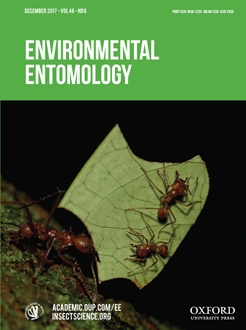Huifang Wang, Tao Ma, Qiang Xiao, Panrong Cao, Xuan Chen, Yuzhen Wen, Hongpeng Xiong, Wenquan Qin, Shiping Liang, Shengzhe Jian, Yanjun Li, Zhaohui Sun, Xiujun Wen, Cai Wang
Environmental Entomology 46 (6), 1365-1373, (24 October 2017) https://doi.org/10.1093/ee/nvx168
KEYWORDS: Camellia sinensis, Ectropis grisescens, emergence, preference, pupation
Ectropis grisescens Warren (Lepidoptera: Geometridae) is one of the most severe pests of tea plants in China. This species commonly pupates in soil; however, little is known about its pupation ecology. In the present study, choice and no-choice tests were conducted to investigate the pupation behaviors and emergence success of E. grisescens in response to different substrates (sand, sandy loam 1, sandy loam 2, and silt loam) and moisture contents (5, 20, 35, 50, 65, and 80%). Moisture-choice bioassays showed that significantly more E. grisescens individuals pupated in or on soil (sandy loam 1 and 2 and silt loam) that was at the intermediate moisture levels, whereas 5%- and 35%-moisture sand was significantly more preferred over 80%-moisture sand for pupating. Substrate-choice bioassays showed that sand was most preferred by E. grisescens individuals at 20%- and 80%-moisture levels, but no preference was detected among the four substrates at 50%-moisture content. No-choice tests showed that the percentage of burrowed E. grisescens individuals and pupation depth were significantly lower when soil was dry (20% moisture) or wet (80% moisture). In addition, 20%-moisture sandy loam 2 and silt loam significantly decreased the body water content of pupae and emergence success of adults compared to 50%-moisture content. However, each measurement (percentage of burrowed individuals, pupation depth, body water content, or emergence success) was similar when compared among different moisture levels of sand. Interestingly, pupae buried with 80%-moisture soil exhibited significantly lower emergence success than that were unburied.


